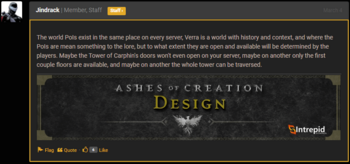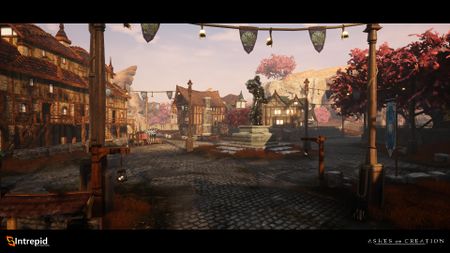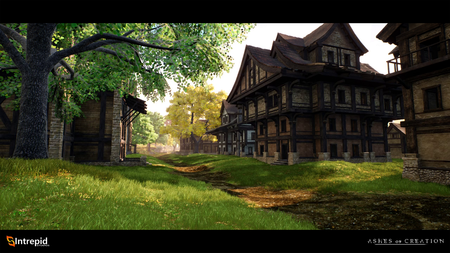Node fejlődés
Nodes advance by collecting experience from the actions of players nearby. As players complete content inside of a Node’s Zone of Influence (the area around the node), they contribute that experience toward the Node’s development. The experience given to the Node may then be modified based on certain Events and Accomplishments. When a Node reaches the experience required, it undergoes the process of advancing to the next stage. There are a few exceptions where a Node cannot advance even though it has the required experience - most commonly, a Node can not advance if a Node is a Vassal of another Node and would advance to the same stage as its Parent Node.[1] – Margaret Krohn
A lakosok, és nem lakosok aktivitása (küldetések, gyűjtögetés, Raid-elés, stb.) a Node ZOI-ján belül annak a Node-nak a fejlesztését gyarapítja (fejlődés).[2] A Node-ok hét (7) fejlődési fázissal rendelkeznek, melyek mindegyikéhez hozzá van rendelve egy elérendő tapasztalatküszöb, a fejlesztéshez.[3]
| Node fázis.[2] | Alternatív név.[4] | Fejlesztéshez szükséges idő.[2] | Játékos lakások.[5] | |
|---|---|---|---|---|
| 0. | Vadon | - | ||
| 1. | Expedíció | Kereszteződés | Pár óra | - |
| 2. | Táborhely | Tábor | Órák | - |
| 3. | Falu | - | Pár nap | Kis házak |
| 4. | Kis város | - | Napok | Közepes házak |
| 5. | Város | - | Pár hét | Nagy házak |
| 6. | Metropolisz | Nagyváros | Hetek | Kastélyok |
The Development Area of a Node is where civilization will appear as the Node advances. As the Node Stage increases, different buildings, NPCs, and services will become available in the Development Area. The higher the Node Stage, the more complex and populated the Development Area becomes. Development Areas will also vary depending on the Node Type - Economic, Military, Scientific, or Divine; we’ll go into further details on each of those Node Types in future posts in this series.[1] – Margaret Krohn
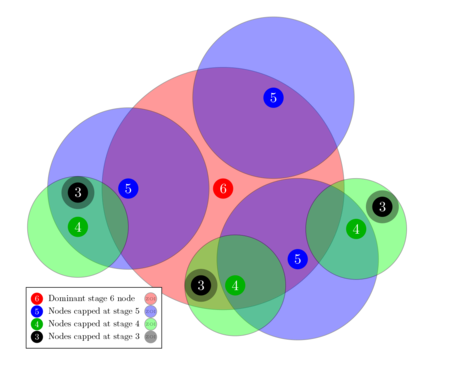
Beginning at Node Stage 3, when a Node advances, it enslaves nearby Nodes and makes them into its Vassals. Vassal Nodes are owned by a Parent Node and must always be at least one Node Stage below the Parent Node. This means that the Vassal Node cannot grow until the Parent Node advances in stage. Vassal Nodes give excess experience to their Parent Node, and are able to have their own Vassals, as long as they fit within the Parent Node’s Zone of Influence. They are subject to the government, alliances, wars, taxes, and trade of their Parent Node, and are able to receive federal aid from them. A Vassal Node cannot declare war on their Parent Node or any of its Vassals. Citizens of Vassals are bound by the diplomatic states of the Parent Node.[3] – Margaret Krohn
Egy Node fejlesztése elérhetővé teszi az egyedi tartalmát, amivel egyidejűleg egyre nagyobb körzetben akadályozza meg a szomszédos Node-ok fejlődését.[7]
- A Node-ok gyorsan érik el az első szintet. Ez elérhetővé teszi az NPC szolgáltatásokat, mint a bolt, vagy tárgyak eltárolása.[8]
- Minél fejlettebb egy Node, annál nagyobb a hozzá tartozó ZOI.[9]
- Kevésbé fejlett Node-ok (avagy vazallus Node-ok) amik fejlettebb Node ZOI-ján belül vannak, szerezhetnek további tapasztalatot, de nem fejlődhetnek a domináns Node szintjére.[6]
- A vazallus rendszer akkor lép életbe, ha egy Node eléri a 3.fázist (Falu), de a szomszédos, hármasnál kisebb Node-ok is megakadályozzák a közvetlen szomszédaik fejlődését.[10]
- A terület kiterjesztő algoritmus figyelembe veszi a legközelebbi tengerpartot, a szomszédos Node-okat és a környezetében lévő területek játékos-sűrűségét az elmúlt hetekben.[11]
- Azon okból, ahogy a kiterjeszkedést számító algoritmus kiszámolja egy növekedő Node ZOI-ját, előfordulhat, hogy két azonos szintű Node egymáshoz közel esik.[12]
The way that the algorithm expands the territories takes into account a few things: One it takes into account the coast like where's the closest coast. Two it takes into account the neighboring nodes so it can take over and essentially vassal state those nodes, but what's more important is essentially the initial population based on like how players choose their races. Because we have nine different races and four different starting points that branch out, each server's population density is going to dictate essentially the first few nodes that are that are highly populated and then that initial seed is what's going to determine the node structure as it moves inland into the into the world essentially; and based on the performance and successes of different sieges will determine which nodes that got locked out from the previous the initial advancements what nodes can now be available to advance further. So I really think that with so many variables that are present in the equation of how nodes advance and stay existing with the more variables you have, the higher likelihood there is for there to be a significant diversion in world progression.[11] – Steven Sharif
Normally the algorithm that's applied to the node territorial expansion will prevent significant nodes from being in close proximity to each other... There could be a perfect storm where all of the algorithmic progression of territory leads to having these nodes very close to each other because there's certain requirements that should that need to be available to satisfy node vassal takeovers; and it's possible that two nodes would never take each other over as vassals and end up close together and spanning their territories in opposite directions: The Tale of Two Cities thing.[12] – Steven Sharif
- A domináns Node nem kap tapasztalatot a vazallus Node-ok területén szerzet tapasztalatból, amíg azok el nem érik a számukra elérhető legnagyobb szintet.[6]
- A játékosok mozgatva(elteleportálva) lesznek, ha a fejlődés közben egy megjelenni készülő épület útjában vannak.[13]
- Egy Node lakosai gyarapíthatják egy eltérő Node fejlesztését.[14]
- A fejlődés konkrét tapasztalat követelménye (pl. hány szörnyet kell megölni) nem lesz nyilvánosan tudott, a rendszer kihasználását elkerülendő.[15]
Different people have different resources invested in nodes progressing and it would be a little "gamey" if you could know exactly what was necessary at that point because that would disincentivize people from participating.[15] – Steven Sharif
Vassal nodes
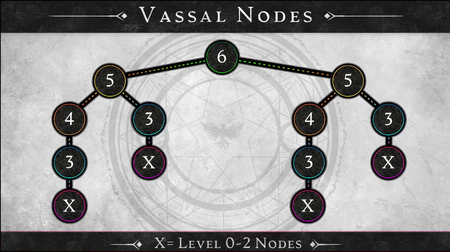
This vassal mode structure tells you what it looks like for a sovereign at a level six metropolis stage; and what it can control at a maximum vassal network is two level five nodes, of which a level five node can control one level four and one level three as direct vassals; and then the four can control a three; and every three can control a one or a two. Now if the three gets removed through siege, the one or the two is removed as well. So that's an important distinction between the three's vassals, which technically isn't really a vassal relationship because there's no citizenships possible. Those vassals don't exist between three and X, but they do exist between four and three, five and four, and six and five. And what this also allows is that because there are 85 nodes that are within the world, we have a buffer zone of about 20 nodes that lives in a max server state. So if you had maximum five metropolises form in a world, you will have a number about 20 nodes that can live alongside those metropolis networks; and when or if a metropolis falls, that extra cushion of nodes around the five metropolis structures allows for the map to be redistricted in a way that is unique. It doesn't mean that one of the fives is just going to pick up where the last six left off and form the same exact metropolis structure. From a territory perspective it has ancillary nodes to play with and expand towards that redistricts the map, so that if a metropolis falls there's a significant difference in the layout of the world and the layout of these almost nation-like territories.[16] – Steven Sharif
Village (stage 3) or higher nodes enslave nearby nodes, converting them into vassal nodes.[3][10]
- A Metropolis (színpad 6) can control up to two City (színpad 5) nodes. A City (színpad 5) can control one Town (színpad 4) and one Village (színpad 3) node. A Village (színpad 3) can control an Encampment (színpad 2) or an Expedition (színpad 1). If the Village (színpad 3) gets destroyed through a siege, its dependant Encampment (színpad 2) and Expedition (színpad 1) nodes are also destroyed.[16]
- There is a layer of intricacy between how the neighboring nodes advance and what potential parent structure they have in the vassalship tree.[17] – Steven Sharif
- Vassal nodes gain benefits from their regent node (also referred to as sovereign node or parent node) even if the node type of the parent is different to the vassal.[18][19]
- It is not a bad thing to be vasseled, it is a good thing to be vasseled. It brings many benefits from the Sovereign, which is the ultimate parent of that vassal network down to the vassal node itself; and it allows that vassal node to even live outside of its normal mechanics. You get to adopt some of the benefits that the node type of your sovereign is, even if your node type as a vassal node isn't the same.[19] – Steven Sharif
- Regent nodes collect taxes from their vassal nodes. These taxes cannot be taken by the mayor or other players.[21]
- Vassal nodes must remain at least one node stage below their parent node.[3]
- Neighboring/Adjacent nodes from Expedition (színpad 1) upward block the growth of their immediate neighbors. This was intended to be tested in Alpha-1.[22][10]
- Vassal nodes first apply any experience earned to their own deficit (see Node bomlás). It then applies excess experience earned to its parent node.[1]
- If the parent node advances, the vassal is once again able to advance.[3]
- Vassal nodes give excess experience to their parent node and may have their own vassals; so long as they fall within the parent node’s zone of influence.[21][3]
- If a node is capped and is both a vassal and has its own vassals, any experience earned from itself or its Vassals is first applied to its own deficit. Experience beyond that is then sent to its parent node.[1]
- When the vassal reaches its cap it overflows experience up to the parent; and so it can be very good early on for parents to get vassal nodes that are very productive- that have a lot of traffic.[21] – Steven Sharif
- Vassals are subject to the government, alliances, wars, taxes, and trade of their parent node, and are able to receive federal aid from them.[3]
- Vassal nodes cannot declare war on their parent node or any of their vassals.[3]
- Citizens of vassals are bound by the diplomatic states of the parent node.[3]
- If a Node is a Vassal Node and is capped from advancing further, it first applies any experience earned to its own deficit (see Node Atrophy section), and then applies excess experience earned to its Parent Node. If the Parent Node advances and the Vassal is able to grow, it becomes uncapped. If a Node is capped and is both a Vassal and has its own Vassals, any experience earned from itself or its Vassals is first applied to their own deficit. Any experience beyond that is then sent to its Parent Node.[1] – Margaret Krohn
Node-ok

A Node-ok előre meghatározott helyszínek, amiket a hatáskörzetük vesz körül, majd pedig különböző méretű településeknek adnak otthont. Ez a méret kis tábortól burjánzó Metropoliszig terjed, és a játékosok hozzájárulásától függ. Nem a játékosok határozzák meg határait, de azon belül lehet saját birtokuk. Egy Node önkormányzatának részét képező játékosok befolyásolják az épületeinek helyét, típusát, azt módosíthatják, ezzel az elérhető szolgáltatások is befolyásolva. Többnyire viszont a Node a saját alakja mentén növekedik. Magát a települést körbevevő területet a Node hatáskörzetének nevezzük, itt tevékenykednek a játékosok miközben a Node szintjét gyarapítják.[23]
Minden szerveren alapos megfontolással elhelyezett Node-ok találhatóak.[2]
- 103 általános Node helyszín lesz megjelenéskor, ami a további 15 vár Node-dal (5 vár x 3 vár Node váronként)[25][26][27] együtt összesen 118 Node.[3][28]
A Node-ok a világ szívét képezik, az élet folyásának irányát alakítják. Alapvetően, ezek előre meghatározott városnak kijelölt helyszínek, amiket a hatáskörzetük, és földrajzi alakzatok vesznek körbe, ami idővel változhat a játékosok aktivitása révén. A világtérkép régiókra van bontva, melyeket több Node tesz ki. Ahogy egy Node növekedik, változik a területén belül, és akörül elérhető tartalom. A játékosok nem hoznak létre Node-okat, de ha egy konkrét Node önkormányzatának részét képezik, akkor befolyásolhatják annak diplomáciáját, módosíthatják az építményeinek helyét/típusát, és az ezáltal elérhető szolgáltatásokat. Megjelenéskor 103 Node lesz a világban, amik egyenként befolyásolják annak történetét és fejlődését.[3] – Margaret Krohn
Storyline quests
Story arc quests (Storyline quests/Narrative quests) contain objectives for each chapter of a story arc.[29][30][31][32][33][34]
- Players can progress each chapter by completing story arc quests within the timeframe that each chapter is active.[31]
- Story arcs can branch into different stories with multiple possible endings depending on the quest objectives that players complete during each chapter.[29][30][32]
- You can't really farm the quests in any meaningful way, because once you've done the quests in a chapter, that's it until the next chapter. Whether 1000 people participate or 10, the chapters will stay active for the same length of time, and as long as you participate in the clearly-marked time frame in your quest journal, you're good. The only thing that a concentrated effort can help with is influencing the narrative paths through the arcs.[35] – Skott B
- These quests stages can be failed. The ability to retry a failed quest depends on Node progression.[32]
- There will be many different quests that actually have stages of the storyline; and these stages can actually be failed. You can actually fail a storyline; which sucks when you think about it, but at the same time that risk makes your investment that much more important.[32] – Steven Sharif
- Quests may differ based on the stages of nearby nodes, seasonal influences, and events such as world bosses.[36]
- Quests involving citizens from multiple nodes are unlocked based on the alliances and other relationships between the nodes and their progression.[37]
Node development
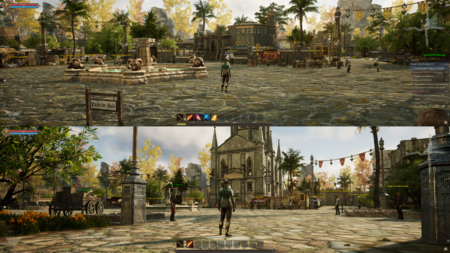
The layout and architecture within a Node’s development area are determined by influential race. For example, a stage 3 Node with the majority of player contribution being Py'rai would have a Py'rai village with Py'rai architecture. Most NPCs would be Py'rai elves, and offer questlines within the Py'rai narrative.[3] – Margaret Krohn
Each player’s contributed experience is flagged with their character race and other identifiers. When a Node advances, the race with the highest experience contribution determines the Node’s style and culture. This style and culture change can happen at every Node Stage. For example, if a Node advances to Level 2 - Encampment Stage and 51% of all experience was earned by Ren’Kai players, the Node will be a Level 2 Ren’Kai Node. If that same Node advances to a Level 3 - Village Stage Node, but the Py'Rai contributed 62% of all the experience earned, then the Node will be a Level 3 Py'Rai Node.[1] – Margaret Krohn
Node layout and style is determined by several factors:[38][39]
- The way that the node system is built is that they can exist across a spread of 18 biomes, but at the same time have to represent the cultural influence of these cultures that are intrinsically a part of a specific biome.[40] – Steven Sharif
- Environment (biome) and location of the node.[40][38][39]
- Nodes will adjust the local topography to fit the aesthetic and mechanical requirements of the node.[41]
- Currently the way that the platform system is set up, is it's capable of adjusting the topography of the node's footprint, regardless of the surrounding terrain. So the reason for that is we want to have flexibility in the presentation of the node's layout and how it is essentially both from an aesthetic standpoint as well as a mechanical standpoint with node sieges- how it's constructed and that construction should have the ability to take on a variance of different types of topography. So it shouldn't be dependent on the surrounding area. Now that's not to say that the surrounding area isn't going to have some influence over. So for example... we're experimenting a little bit with the platform tech and putting up a node up against the side of a mountain or on the edge of a cliff or something that has a beautiful vista. Those are things that we're going to test out obviously as we continue to work on the node tool and how that platform system works, but the idea is to have the node independent of the surrounding terrain.[41] – Steven Sharif
- Some parts are determined by the area it's in. Some parts are determined by the type it is. Some parts are determined by the race it is; and then the rest of it is determined by the mayor.[39] – Jeffrey Bard
- Race that contributed the highest percentage to the node's advancement will alter the racial appearance of its buildings, NPCs, and props.[42][43][38][1][39][44][45]
- All nodes, whether they're associated with a castle or associated with normal node structure, has cultural influences that replicate over to the buildings that are produced and the NPCs that are present.[47] – Steven Sharif
- The rest is determined by the node's mayor.[39]
- It should be possible for a node to complete several building projects within a mayor's one month term in office.[48]
- Q: How long would you say it will take players on average to fill/build up a node completely from wilderness to metropolis?
- A: It's one thing to get a node to a certain level: it's another thing to develop the node; and I can't really give you an on-average expectation, because there's a lot of variables at play. There's how many citizens does the node have attracted to it; what's the type of traffic that the node is attracting to it based on things like its tax rates, or the specialization that it chose to spec into, based on the building types it's chosen to build. All of those things are variables that can affect the quote-unquote "average build-out time" of a particular node. So it's difficult to give you an average when there's so many variables along those lines. But the idea is that if there is a particular project that players are interested in in developing based on the node stage, that they would have the ability to complete several of those projects as within a single term of a mayor; and a term of a mayor is one month.[48] – Steven Sharif
Taxation
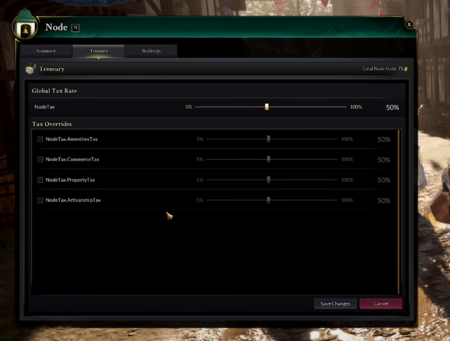
As the node levels up, you're gonna get access to deeper controls on the taxes, so that you as a Mayor can incentivize players to come to your node to do certain things. If you're a node that loves smithing, you're probably going to want to lower your taxes on artisanship to incentivize players to be here. But then you might want to drive up taxes on other avenues that players aren't necessarily coming to your node for, but are using out of convenience.[49] – Chris Justo
Mayors are able to set a generalized node tax rate as well as overrides for different activities within their node. Mayors gain additional taxation controls as their node advances.[49][50]
- Amenities tax override.[49]
- Artisanship tax override.[49]
- Commerce tax override.[49]
- This may include taxes that apply to tavern games.[51][52]
- Property tax override.[49]
- Freehold property taxes scale according to the number of freehold building permits issued for that freehold.[53][54][55]
- Citizenship dues and property taxes scale based on the stage of the node when a player became a citizen.[56][57][58][59][60]
- The goal is to exert financial pressure on node populations by making taxes increasingly expensive as nodes advance, rather than putting in place hard population caps.[58][59]
- Node tax rates will be visible on the world map by hovering over a node location.[61]
- Tax revenue only goes toward funding node development. This cannot be withdrawn by the mayor or any other player.[21][55]
Regent nodes take a cut of taxes from various activities that occur within their vassal node structure.[21][62]
- This tax doesn't necessarily impact the individual citizen, because citizen's tax levels are determined by their node, but the node's finances are affected by the taxation levied by its parent nodes.[62]
Player housing
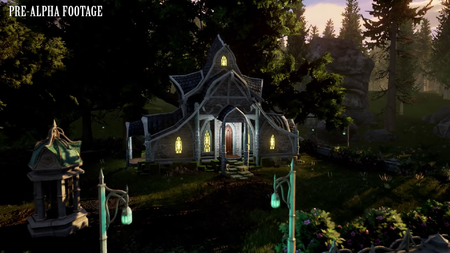
Players will have the ability to survey and develop land anywhere in the world. Be a pioneer deep in the wilderness, build the home of your dreams, and work the land to cultivate resources and supplies. Alternatively, stick with civilization and safety in numbers – purchase a home within the confines of a village and watch your investment grow as that village turns into a city. Homeowners in our game will have the ability to develop their plot of land as they see fit. Focus on farming, animal husbandry, or own your very own smithy. You’ll be able to specialize your land to maximize your profits or your comfort – be sure to choose wisely.[64]
Player housing is player-owned accommodation in the form of Apartmanok, Freeholds, Inns, and Static housing.[57][9]
A player may own up to one of each type of housing simultaneously.[66][67] Static housing and Apartmanok are one per server; Freeholds are one per account.[68]
| Player housing | Type. | Availability. | Starting count. | Limit. |
|---|---|---|---|---|
| Apartmanok | Instanced.[9] | Village stage and higher.[69] | 50.[70] | One per character per server.[68] |
| Freeholds | Open world.[9] | Village stage and higher.[9] | Low thousands per server.[71][72] | One per account.[68] |
| Inns | Instanced.[73] | Starting areas and Node-ok.[57] | Most accessible.[57] | - |
| Static housing | In-node.[9] | Village stage and higher.[9] | 8.[70] | One per character per server.[68] |
- If you were to think about the level of exclusivity between the different types of housing that we have, obviously the most exclusive when it comes to a quantity is going to be Freeholds, followed by In-node housing, followed by Apartments, then followed by Inns.[74] – Steven Sharif
Trophy park
Trophy park is an area within Town, City or Metropolis nodes that has available spots for trophies. These trophies show the character names of players who are the first to complete world bosses and dungeon bosses that were spawned as the result of the development of that particular node.[75]
- Server announcements and achievements are designed to encourage groups to experience new content.[75]
Adaptive content

This is actually a dynamic POI. This one will evolve as players evolve the node that it's attached to. So this is its final state.[76] – Jeffrey Bard
New points of interest (such as dungeons, world bosses, and corrupted areas) spawn as nodes develop.[77][78] This content adapts to the node progression of the zone it is in.[76][79]
- Additional buildings will spawn.[76]
- Additional mobs will spawn.[76]
- Different antagonists/leaders with different story lines.[76][79]
- Populations will change.[79]
- Content difficulty will change.[79]
- The content may be different altogether.[79]
- Additional quest hooks.[76]
- Dungeons will be unlocked when certain nodes advance to certain stages.[34]
- Drop tables in areas and dungeons will be tied into the progression of certain areas.[34]
- POI events are events that relate to specific points-of-interest (POI).[83]
- The location of points of interest will be the same on each server, but some servers may have limited or no access to them.[84]
- Certain dungeons and other points of interest across the map will all be affected by the server’s node development. Some dungeons will only be unlocked if nodes are developed to certain stages. The storyline objectives for players inside dungeons will also be dependent on the story arc paths chosen through the node system. The drop tables in area and dungeons will also be tied into the progression of certain areas. For example, let’s say that the humans have developed a node in Region A, and a storyline has opened up that leads players to inspect the ruins (dungeon) of a nearby area. And let’s say that this node was developed in a scientific (crafting) zone… Well before the node developed, this dungeon was accessible… But now the dungeon has propagated new monster assets that include a drop table catering to a crafting emphasis because of the development of that academic node. And perhaps, a new boss appears in different rooms of the dungeon that includes different adventure quest starts, like a mysterious item with a storyline that can only be progressed if a node develops to the metropolis stage in a certain region, across the world. Our system is so vast, when it comes to interconnectivity and how the world reacts to the players.[34]
Továbbiak
Hivatkozások
- ↑ 1.0 1.1 1.2 1.3 1.4 1.5 1.6 1.7 Blog - Know Your Nodes - Advance and Destroy.
- ↑ 2.0 2.1 2.2 2.3 A reactive world - Nodes.
- ↑ 3.00 3.01 3.02 3.03 3.04 3.05 3.06 3.07 3.08 3.09 3.10 3.11 Blog - Know Your Nodes - The Basics.
- ↑ Élő adás, 2018-12-12 (14:48).
- ↑ Interjú, 2020-07-20 (3:45).
- ↑ 6.0 6.1 6.2 Élő adás, 2017-10-16 (50:20).
- ↑ Video, 2017-04-20 (0:02).
- ↑
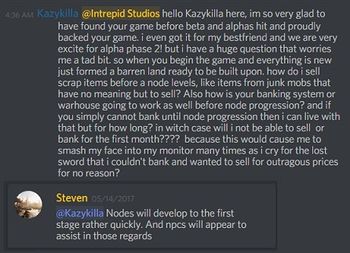
- ↑ 9.0 9.1 9.2 9.3 9.4 9.5 9.6 9.7 Node series part II – the Metropolis.
- ↑ 10.0 10.1 10.2

- ↑ 11.0 11.1 Interjú, 2020-07-18 (10:04).
- ↑ 12.0 12.1 Interjú, 2020-07-08 (1:00:15).
- ↑ Élő adás, 2017-11-17 (55:27).
- ↑
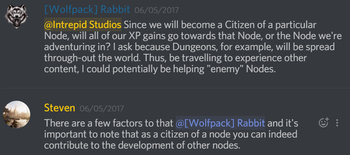
- ↑ 15.0 15.1 Élő adás, 2017-05-26 (28:16).
- ↑ 16.0 16.1 16.2 Élő adás, 2022-08-26 (1:07:34).
- ↑

- ↑ Élő adás, 2023-08-31 (52:56).
- ↑ 19.0 19.1 Élő adás, 2022-08-26 (1:04:35).
- ↑

- ↑ 21.0 21.1 21.2 21.3 21.4 Élő adás, 2022-08-26 (1:10:16).
- ↑

- ↑ Node series part I
- ↑ Ashes of Creation - Screenshots.
- ↑ Blog: 10 facts about castle sieges in the MMORPG.
- ↑
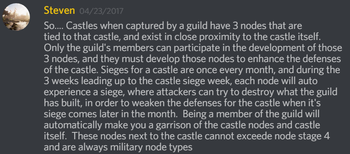
- ↑ Podcast, 2018-04-23 (15:14).
- ↑ Interjú, 2018-08-24 (3:44).
- ↑ 29.0 29.1 Élő adás, 2023-04-07 (58:39).
- ↑ 30.0 30.1 30.2 Video, 2023-03-31 (14:20).
- ↑ 31.0 31.1 Video, 2023-03-31 (12:47).
- ↑ 32.0 32.1 32.2 32.3 Interjú, 2018-10-20 (2:36:25).
- ↑ Élő adás, 2018-01-18 (39:08).
- ↑ 34.0 34.1 34.2 34.3 34.4 MMOGames interview, January 2017
- ↑ 35.0 35.1

- ↑ Élő adás, 2021-03-26 (1:12:51).
- ↑ Élő adás, 2020-07-25 (1:50:20).
- ↑ 38.0 38.1 38.2 Élő adás, 2020-10-30 (39:17).
- ↑ 39.0 39.1 39.2 39.3 39.4 39.5 Élő adás, 2018-09-27 (53:06).
- ↑ 40.0 40.1 Élő adás, 2022-02-25 (41:00).
- ↑ 41.0 41.1 Élő adás, 2021-02-26 (1:12:18).
- ↑ Élő adás, 2022-03-31 (4:57).
- ↑ Podcast, 2021-04-11 (29:47).
- ↑ Interjú, 2018-05-11 (54:34).
- ↑ Élő adás, 2017-05-26 (21:23).
- ↑ Podcast, 2021-04-11 (23:36).
- ↑ 47.0 47.1 Interjú, 2018-05-11 (47:27).
- ↑ 48.0 48.1 Élő adás, 2022-07-29 (1:13:09).
- ↑ 49.0 49.1 49.2 49.3 49.4 49.5 49.6 49.7 Video, 2023-08-31 (28:04).
- ↑ Élő adás, 2020-03-28 (1:03:38).
- ↑

- ↑

- ↑ Interjú, 2023-07-09 (54:46).
- ↑ Élő adás, 2023-06-30 (1:45:22).
- ↑ 55.0 55.1

- ↑ Blog: Development Update with Village Node.
- ↑ 57.0 57.1 57.2 57.3 Élő adás, 2023-08-31 (15:51).
- ↑ 58.0 58.1 Interjú, 2023-07-09 (38:14).
- ↑ 59.0 59.1 Interjú, 2020-03-27 (0:30).
- ↑ Video, 2018-04-05 (41:48).
- ↑ Élő adás, 2023-09-29 (1:11:22).
- ↑ 62.0 62.1 Interjú, 2018-05-11 (57:02).
- ↑ Video, 2017-05-25 (1:07).
- ↑ About Ashes of Creation.
- ↑ Élő adás, 2018-05-04 (32:46).
- ↑ Interjú, 2023-07-09 (42:11).
- ↑

- ↑ 68.0 68.1 68.2 68.3 Interjú, 2018-05-11 (50:47).
- ↑ Steven Sharif - Clarification points from today’s stream.
- ↑ 70.0 70.1

- ↑ Blog: Exploring the Boundless Opportunities of Freeholds.
- ↑

- ↑ Élő adás, 2023-08-31 (22:32).
- ↑ Élő adás, 2023-08-31 (18:13).
- ↑ 75.0 75.1 Podcast, 2018-08-04 (1:35:58).
- ↑ 76.0 76.1 76.2 76.3 76.4 76.5 76.6 Élő adás, 2021-03-26 (50:33).
- ↑ Élő adás, 2021-03-26 (22:53).
- ↑ Élő adás, 2017-11-17 (36:22).
- ↑ 79.0 79.1 79.2 79.3 79.4 Élő adás, 2017-11-17 (18:29).
- ↑

- ↑

- ↑ Élő adás, 2020-07-25 (46:08).
- ↑ Élő adás, 2022-04-29 (40:21).
- ↑
